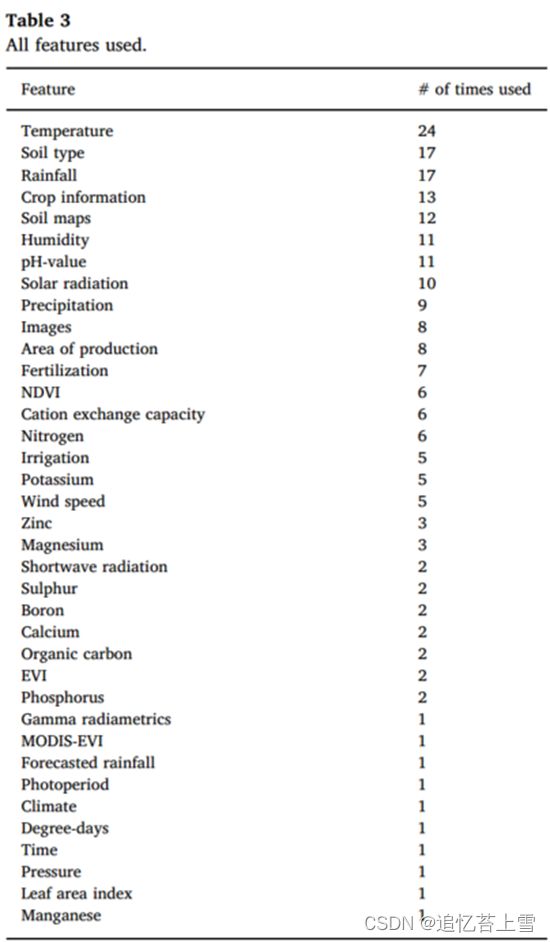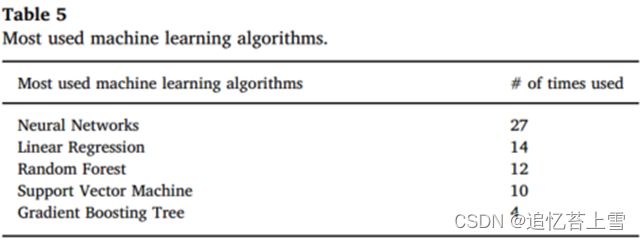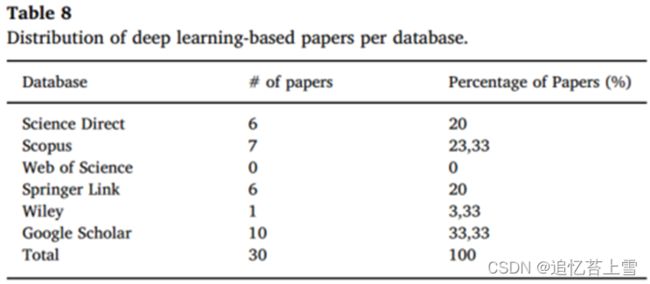论文阅读--Crop yield prediction using machine learning: A systematic literature review
摘要: Machine learning is an important decision support tool for crop yield prediction, including supporting decisions on what crops to grow and what to do during the growing season of the crops. Several machine learning algorithms have been applied to support crop yield prediction research. In this study, we performed a Systematic Literature Review (SLR) to extract and synthesize the algorithms and features that have been used in crop yield prediction studies. Based on our search criteria, we retrieved 567 relevant studies from six electronic databases, of which we have selected 50 studies for further analysis using inclusion and exclusion criteria. We investigated these selected studies carefully, analyzed the methods and features used, and provided suggestions for further research. According to our analysis, the most used features are temperature, rainfall, and soil type, and the most applied algorithm is Artificial Neural Networks in these models. After this observation based on the analysis of machine learning-based 50 papers, we performed an additional search in electronic databases to identify deep learning-based studies, reached 30 deep learning-based papers, and extracted the applied deep learning algorithms. According to this additional analysis, Convolutional Neural Networks (CNN) is the most widely used deep learning algorithm in these studies, and the other widely used deep learning algorithms are Long-Short Term Memory (LSTM) and Deep Neural Networks (DNN).
作物产量影响因素
作物产量预测有不同的方法,本章节调研总结了影响作物产量的不同因素方面的综述文章
| 影响因素 |
结论 |
参考文献 |
| 氮状况估计 |
传感技术和ML技术的快速发展将为农业部门带来具有成本效益的解决方案。 |
Machine learning approaches for crop yield prediction and nitrogen status estimation in precision agriculture: a review. |
| 气候参数 |
建议从广义上寻找更多能说明作物产量的参数 |
Forecasting yield by integrating agrarian factors and machine learning models: a survey. |
| 作物管理、牲畜管理、水管理和土壤管理 |
人工神经网络主要用于实现在作物,水和土壤管理,而支持向量机主要用于牲畜管理层。 |
Machine learning in agriculture: a review. Sensors (Switzerland) |
| 水果成熟度 |
确定最佳收获时间和产量预测 |
Advances in non-destructive early assessment of fruit ripeness towards defining optimal time of harvest and yield prediction—a review. |
| 疾病检测 |
通过疾病检测管控提升产量 |
Role of image processing and machine learning techniques in disease recognition, diagnosis and yield prediction of crops: a review. |
| 数据挖掘 |
使用数据挖掘数据集等数据来解决作物产量预测问题 |
A survey on different data mining techniques for crop yield prediction. |
方法论
Review protocol
Research questions
| RQ |
问题描述 |
| RQ1 |
哪些机器学习算法已在文献中用于作物产量预测? |
| RQ2 |
在使用机器学习进行作物产量预测的文献中使用了哪些特征? |
| RQ3 |
文献中使用了哪些评估参数和评估方法来预测作物产量? |
| RQ4 |
使用机器学习的作物产量预测领域面临哪些挑战? |
Search strategy
| 检索库 |
检索关键词 |
| Science direct |
[“machine learning” AND “yield prediction”] [((“machine learning” OR “artificial intelligence”) AND “data mining” AND (“yield prediction” OR “yield forecasting” OR “yield estimation”))] (Title, abstract, keywords). |
| Scopus |
|
| Web of Science |
[“machine learning” AND “yield prediction”] (title, abstract, author keywords, and Keywords Plus). |
| Springer Link |
[“machine learning” AND “yield prediction”](anywhere) and [((“machine learning” OR “artificial intelligence”) AND “data mining” AND (“yield prediction” OR “yield forecasting” OR “yield estimation”))] (anywhere) |
| Wiley |
|
| Google Scholar |
Exclusion criteria
排除标准见下表;
| RQ |
问题描述 |
| Exclusion criteria 1 |
出版与农业部门,产量预测与机器学习相结合无关 |
| Exclusion criteria 2 |
出版物不是英文文献 |
| Exclusion criteria 3 |
重复发布或已从其他数据库检索到的发布文献 |
| Exclusion criteria 4 |
文献全文不可用 |
| Exclusion criteria 5 |
文献是一份综述文章 |
| Exclusion criteria 6 |
2008年之前出版的文献 |
表1显示了最初检索到的论文数量和应用选择标准后的论文数量,大多数论文都是从Google Scholar、Scopus和Springer数据库中检索到的;图4显示了基于检索数据库的选定出版物的分布情况;
结果
选定的出版物如表2所示。该表显示了这些论文的发表年份、标题和使用的算法。
图 4 显示了过去十年中每年发表的论文数量。该图表明,最近有关作物产量预测的论文数量正在增加。
图5中的饼图显示了出版物类型的分布。
为了解决研究问题二(RQ2),对论文中应用的机器学习算法中使用的特征进行了调查和总结。我们能够提取的所有特征如表3所示。最常用的特征与温度、降雨量和土壤类型有关。作物产量是因变量。为了更好地了解自变量(特征),对特征进行了分组。独立特征可以分为土壤和作物信息、湿度、养分和田间管理。这些组的使用次数如表4所示。如表所示,最常用的特征组与土壤、太阳能和湿度信息有关。
为了解决第一个研究问题(RQ1),对机器学习算法进行了研究和总结。表5列出了多次使用的算法。
为了解决研究问题三(RQ3),确定了评估参数。所使用的所有评估参数及其使用次数如表6所示。如表所示,均方根误差(RMSE)是研究中使用最多的参数。
为了解决研究问题四(RQ4),阅读这些出版物,看看它们是否说明了未来模型的任何问题或改进。在几项研究中,数据可用性不足(数据过少)被认为是一个问题。
基于深度学习的作物产量预测
为了扩大分析范围并了解深度学习算法在产量预测中的最新应用,设计了一个新的搜索标准(即”deep learning” AND “yield prediction”),得出了以下30篇论文,如表7所示,提取并合成了研究人员应用的深度学习算法。表8显示了每个数据库中基于深度学习的论文的分布情况。表9显示了已识别论文列表中应用的深度学习算法的分布
深度学习算法简要描述
| 神经网络 |
描述 |
参考文献 |
| Deep Neural Networks (DNN) |
DNN算法与传统的人工神经网络(ANN)算法非常相似,只是隐藏层的数量不同。 |
|
| Convolutional Neural Networks (CNN) |
与全连接网络相比,CNN需要学习的参数更少。CNN模型有三种类型的层,即卷积层、池化层和全连接层。 |
Deep learning with Python: develop deep learning models on Theano and TensorFlow using Keras |
| Long-Short Term Memory (LSTM) |
LSTM网络是专门为序列预测问题设计的。如原始LSTM、堆叠LSTM、CNN-LSTM、编码器-解码器LSTM、双向LSTM和生成LSTM。 |
Long Short-term Memory Networks with Python: Develop Sequence Prediction Models with Deep Learning. Machine Learning Mastery. |
| 3D CNN |
一种特殊类型的CNN模型,其中卷积核通过高度、长度和深度移动。因此,它会生成3D激活图。 |
3D convolutional neural networks for human action recognition |
| Faster R-CNN |
基于区域的卷积神经网络(RCNN)是一系列专门为目标检测设计的CNN模型 |
Deep Learning for Computer Vision: Image Classification, Object Detection, and Face Recognition in Python |
| Autoencode |
自动编码器是一种无监督的学习方法,由以下四个主要部分组成:编码器、瓶颈层、解码器和重建损失 |
Autoencoders, unsupervised learning, and deep architectures. In: Proceedings of ICML workshop on unsupervised and transfer learning |
| Hybrid networks |
将不同深度学习算法的力量结合起来。因此,研究人员以不同的方式将不同的算法结合起来。 |
An end-to-end model for rice yield prediction using deep learning fusion |
| Multi-Task Learning (MTL) |
在多任务学习中,我们在任务之间共享表示,以提高为这些任务开发的模型的性能 |
An overview of multi-task learning in deep neural networks |
| Deep Recurrent Q-Network (DQN): |
DQN算法是由谷歌于2014年收购的DeepMind的研究人员于2015年开发的。结合了强化学习和深度神经网络 |
Crop yield prediction using deep reinforcement learning model for sustainable agrarian applications |
讨论
| 讨论类型 |
描述 |
参考文献 |
| General discussion |
这类研究容易受到有效性威胁的影响,对有效性的潜在威胁可能是外部的、结构有效性和可靠性 |
Empirical evidence in global software engineering: a systematic review. |
| Search-related discussion |
有可能遗漏了一些有价值的出版物。本可以使用更多的同义词,更广泛的搜索可能会发现新的研究。 |
—————— |
| Analysis-related discussion |
另一个可能威胁有效性的问题是进行分析的方式。例如,并不是所有的出版物都说明使用了什么样的评估参数,有时只解释了几个特征的例子。 |
—————— |
| RQ1-Related (algorithms) discussion |
根据表5,线性回归是第二常用的算法。在大多数情况下,线性回归被用作基准算法,以检查所提出的算法是否优于线性回归。因此,尽管它在许多文章中都有介绍,但这并不意味着它是性能最好的算法。 |
—————— |
| RQ2-related (features) discussion: |
除了在几项研究中使用的特征外,还有一些特征在特定研究中使用。这些特征包括伽马辐射、MODIS-VI、预测降雨量、湿度、光周期、pH值、灌溉、叶面积、NDVI、EVI和作物信息。 |
—————— |
| RQ3-related (evaluation parameters and approaches) discussion |
所选论文评估参数不多。几乎每项研究都使用RMSE作为模型质量的衡量标准。其他评估参数是MSE、R2和MAE。一些参数用于特定研究,这些参数中的大多数看起来像前面提到的一些参数,只是略有差异。 |
—————— |
| RQ4-related (challenges) discussion |
根据文章中的明确陈述报告了挑战。然而,可能还有一些已确定的文件中没有说明的额外挑战。挑战主要是在改进工作模式方面。 |
—————— |
结论
这项研究表明,根据研究范围和数据的可用性,选定的出版物使用了各种特征。每一篇论文都研究了机器学习的产量预测,但与特征不同。这些研究在规模、地质位置和作物方面也有所不同。特征的选择取决于数据集的可用性和研究目的。研究还表明,具有更多特征的模型并不总是为产量预测提供最佳性能。为了找到性能最好的模型,应该测试具有越来越少功能的模型。在不同的研究中使用了许多算法。结果表明,对于什么是最佳模型,还不能得出具体的结论,但它们清楚地表明,一些机器学习模型比其他模型使用得更多。最常用的模型是随机森林、神经网络、线性回归和梯度增强树。大多数研究使用了各种机器学习模型来测试哪种模型的预测效果最好。
由于神经网络是应用最广泛的算法,我们还旨在研究深度学习算法在多大程度上用于作物产量预测。在识别了30篇应用深度学习的论文后,我们提取并合成了应用算法。我们观察到,CNN、LSTM和DNN算法是最受欢迎的深度学习算法。然而,也有其他类型的算法应用于这个问题。我们认为本文将为进一步研究作物产量预测问题的发展铺平道路。
在我们未来的工作中,我们的目标是在这项研究的基础上,重点开发基于DL的作物产量预测模型。














